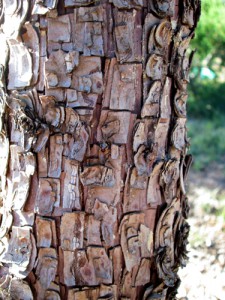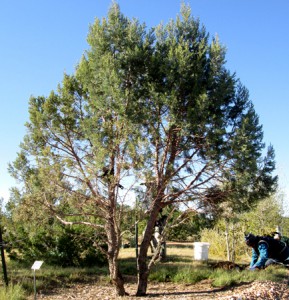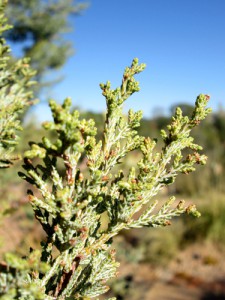Scientific name: Juniperus deppeana

Alligator juniper bark (Photo: Cristina Salvador)
Common name: Alligator juniper
Plant family: Cupressaceae – Cypress
Article by Susan Bruneni
Santa Feans are very familiar with the one-seed juniper (Juniperus monosperma) that adorns much of our terrain. But a distinctive juniper usually not found above 6,000 feet is growing at the Botanical Garden at Museum Hill. It is the Alligator juniper, or Juniperus deppeana. The bark clearly resembles alligator skin, different from any other of the 50-60 species of juniper.
Unlike the shrub-like one-seed juniper, the alligator juniper forms one or more central trunks. It grows in southern and western New Mexico, west Texas, Arizona and northern Mexico. Depending on climate conditions, the alligator juniper can reach heights to 45 feet and spread to 35 feet. It is heat and drought tolerant and will simply stop growing during drought conditions and remain dormant until moisture resumes. Alligator junipers can live to be 500 years old, with trunks more than 20 feet in diameter. The male plants produce ½-inch cones and the female plants produce ½-inch whitish blue berries containing two-to-six seeds.

Alligator juniper (Juniperus deppeana) growing in Botanical Garden at Museum Hill. (Photo: Cristina Salvador)
Alligator wood is hard and suitable for furniture construction. It is also used for firewood and produces an excellent pitch, widely used for water-proofing. On Zuni, children use the pitch for chewing gum, and berries are eaten raw or steamed. Zuni and Hopi recipes frequently include juniper ash as an ingredient.

Scale-like leaves of the Juniperus deppeana (Photo: Cristina Salvador)
Medicinal applications include stomach remedies and use before and after childbirth. In Healing Herbs of the Upper Rio Grande, Leonora Curtin wrote that both the Zuni and Tewa people used juniper bark for kindling and toasted twigs were applied to relieve bruising and swelling. The Navajo treated diabetes with juniper.
And unlike most other junipers in and around Santa Fe, the Botanical Garden’s Alligator juniper has its own name (Allie) and is the star of an educational book entitled, The Wondrous World of Trees (to download a pdf copy, click here). The book was designed for one of the Garden’s activity backpacks available to any visitor, adult or child, who would like to borrow it for fun reading, games, take home handouts, and much more. Visit the Learn section of our website to read more about the many educational programs available at Botanical Garden and other sites.
Sources:
plants.usda.gov
US Forest Service http://www.fs.fed.us
Wikipedia
Healing Herbs of the Upper Rio Grande by L.S.M. Curtin
A Treasury of American Indian Herbs by Virginia Scully



